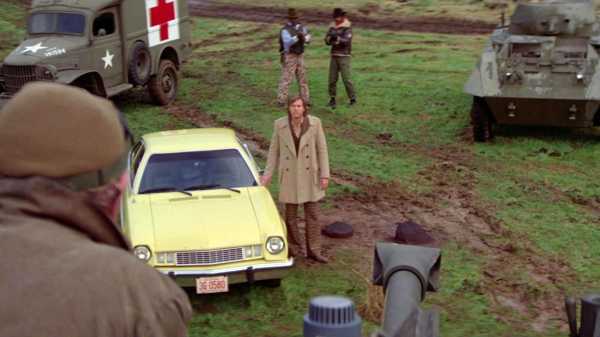
Save this storySave this storySave this storySave this story
Conspiracy theories are faith-based history, and “Winter Kills,” a 1979 neo-noir, riffs on a scriptural pillar of this realm—the assassination of President John F. Kennedy—with freewheeling speculations that feel both heretical and metaphysical. The movie (which is coming Friday to Film Forum, in a new restoration, and is also widely streaming) stars Jeff Bridges as Nick Kegan, an heir without portfolio, whose claim to fame is that his older half brother Timothy was murdered in 1960, while serving as President. Now, nineteen years later, while aboard an oil tanker belonging to their colossally wealthy father, Nick gets a tip regarding the murder weapon, which had never been found. Following up on that lead, he’s drawn into a whirlwind of danger and deceit that shakes the very foundations of his ideals, his relationships, and his place in the world.
There are so many startling revelations and elaborate deceptions in “Winter Kills” that more or less any discussion of the plot counts as a spoiler (which I define as any detail I’m glad not to have known going in). Let’s just say that it’s a very strange movie, and its tone and aesthetic reflect its idiosyncratic concept. (Written and directed by William Richert, it’s based on a novel by Richard Condon.) Fortunately, there’s plenty going on in the film besides just plot, but little of it involves psychology, because the character development is virtually nonexistent. Even Nick’s deepening exploration of a wide variety of American underworlds—ranging from the familiar ones of seedy crime bosses to bewilderingly vast networks of surveillance and manipulation—is hardly an existential adventure. Indeed, the adventure he embarks on, with increasingly frenetic and violent efforts to uncover tantalizingly elusive truths, feels almost radically impersonal, because Nick himself is largely a blank. Where one might expect psychological drama, Richert leaves an abyss across which the movie giddily, madly howls, evoking a paranoiac vision of illusions, schemes, and shadowy manipulators who appear able to bend history and even present-tense reality to their will.
That’s why “Winter Kills” is, above all, an exercise in tone—a crazed, hectic tone that instantly suggests a world irreparably out of whack. What lends the movie substance is the cinematic style that Richert crafts from its dramatic premise. Start at the top: the tip that’s delivered to Nick arrives in a hoarily melodramatic form—a deathbed confession so intense as to obscure the sleight-of-hand absurdity that brings it about. The wildness is amped up even more when Nick follows a lead to a Philadelphia wigmaker’s workshop, where the weapon that was used to kill Tim is said to be stashed. The burst of violence that results from that visit is a distillation of Richert’s distinctive aesthetic: so fast and so devastating that, although physically plausible, it defies reason, thanks to the elaborate coördination and sophisticated technology it would require. The vastness of the implicit backstory here—a universe of secret activity rendered in a mere handful of quick-cut shots—pushes the material world of the thriller toward a more fundamental ontological uncertainty. The murder mystery starts to dissolve into a seemingly cosmic one.
Many elements in “Winter Kills” map right onto the Kennedy assassination. Tom Kegan, played by John Huston with leonine swagger and jackal-like derision, is the Joseph Kennedy, Sr., figure, the rich old tycoon who helped install his son in the White House; the assassin, Lee Harvey Oswald, is here called Willie Arnold, and the gangland-connected man who kills him, in real life Jack Ruby, is called Joe Diamond (played with memorable desperation by Eli Wallach). Then, too, there are suspicions that the Mafia was behind President Kegan’s assassination, and we learn that he was a relentless womanizer while in office—and had a liaison with a glamorous Hollywood actress, who later died by suicide. So far, so roman à clef. What heightens the mood of reality-shredding frenzy is the movie’s addition of a wild array of weird and discordant characters: another tycoon (played by Sterling Hayden), a libertarian who lives at a remote compound and maintains a private tank squad; Pa Kegan’s tightly wound factotum (played by Anthony Perkins), who takes phone calls from a windowless communications center adorned with an image of Earth as seen from outer space; a phlegmatic gangster played by Irving Selbst. Nick is dating a woman named Yvette Malone (Belinda Bauer), who, as a magazine editor, offers to help with his investigation in exchange for an exclusive. (Her answering machine is practically a character, too.) Impostors and impersonators not only populate the milieu that Nick is investigating; they actually seem to have infiltrated his life long ago, so that his experiences and memory start to seem like a delirium of shadow play and mirror games.
Richert runs these games close to the edge of comedy but stops short of seeking laughs, because the symbolic stakes of his playful twists are enormous. When we learn that the patriarch Tom Kegan maintains a surveillance network of dumbfoundingly wide reach and granular intimacy, Richert and his production designer, Robert Boyle, offer an astounding physical rendering of that information complex. In lieu of an omniscient and omnipotent God, “Winter Kills” posits that such absolute powers reside instead in people inhabiting places where they’d never be suspected of reigning, let alone existing. It’s a vision of an overwhelming determinism so tautly maintained that it mocks the very notion of free will, let alone freedom and democracy. It may be a hectic, giddy, absurd movie—but, in its evocation of a conspiracy so logical that it is beyond belief, the film dramatizes the power of such an idea to attract true believers. ♦
Sourse: newyorker.com






